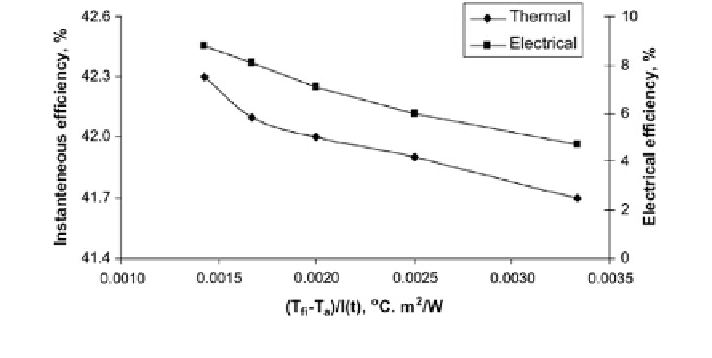Civil Engineering Reference
In-Depth Information
3.3.1 Analysis of the Research Achievements in Terms of PV/T Types
In terms of the system types concerned, the research can fall into four categories,
namely (1) air-based PV/T; (2) water-based PV/T; (3) refrigerant-based PV/T; and
(4) heat-pipe-based PV/T. Of these systems, air- and water-based types are rela-
tively mature technologies and have already been widely used in the practical
projects, while the refrigerant and heat-pipe-based systems are still in research/
laboratory stage and some technical/economic barriers still remain that prohibited
their wide application.
Air-based PV/T
Air-based PV/T is one of the most commonly used PV/T technologies and has
been developed into commercial units or/and used in many engineering practices.
This type of system usually comprises of (1) commercial laminated PV modules;
(2) specially designed air flow channels/ducts; (3) active fans; (4) air-handling unit
or air/air heat exchangers (TWINSOLAR 2010 and SolarWall 2010), and its solar
efficiency behaves as the function of geometrical parameters and external climatic
conditions. The most favourite unit configuration and material are the integrated
frameset of aluminium absorber and lamina-separated channels with either the
presence or absence of built-in commercial PV cells. A diagram showing the
relation between the solar thermal and electrical efficiencies and operational
parameters is given in Fig.
21
(Solanki et al.
2009
).
In overall, a typical air-based PV/T type can achieve maximum electrical
efficiency of around 8 % and thermal efficiency of around 39 % (Solanki
et al.
2009
). Its performance is largely dependent on the air flow speed and
temperature. Researches related to this type of PV/T system usually focus on (1)
studying the more favourite air flow patterns, e.g. buoyancy-driven and forced
flow, (2) determining the optimised channel's geometry and sizes to enable cre-
ating effective turbulence within the channels, and (3) selecting proper glazing
modes, e.g. uncovered or covering with single/double glass. The major problem
Fig. 21
Variation in efficiencies with operating conditions (Solanki et al.
2009
)

